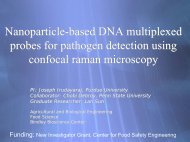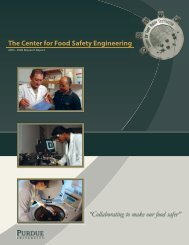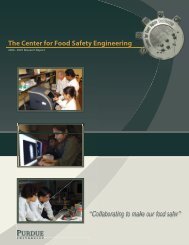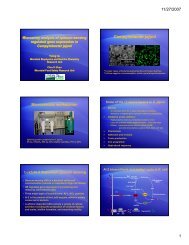Annual Report - Center for Food Safety Engineering - Purdue ...
Annual Report - Center for Food Safety Engineering - Purdue ...
Annual Report - Center for Food Safety Engineering - Purdue ...
Create successful ePaper yourself
Turn your PDF publications into a flip-book with our unique Google optimized e-Paper software.
Bhunia, Hirleman and RobinsonOptical <strong>for</strong>ward scattering <strong>for</strong> bacterial colonydifferentiation and identificationInvestigators: Arun Bhunia (Department of <strong>Food</strong> Science), E. Daniel. Hirleman (School of Mechanical<strong>Engineering</strong>), J. Paul Robinson (Weldon School of Biomedical <strong>Engineering</strong>)Project RationaleThe <strong>Center</strong>s <strong>for</strong> Disease Control and Prevention (CDC)estimates that 76 million people get sick, more than 300,000 arehospitalized, and 5,000 Americans die each year from foodbornepathogen infections. Preventing foodborne illnesses remainsa major public health challenge. Listeria monocytogenes,Escherichia coli, and Salmonella are three major foodbornepathogens of concern in the U.S. L. monocytogenes, alongwith Salmonella and Toxoplasma, are responsible <strong>for</strong> morethan 75 percent of the foodborne diseases and 1,500 deathsevery year compared to the other known pathogens. There hasbeen an increase in foodborne illnesses, multiple outbreaks,product recalls, and loss of lives as a result of the associationwith pathogens in processed, ready-to-eat food. Bacterialcontamination in food not only places the public at risk, it iscostly to companies due to loss of production time, productrecalls, and liability.For detecting and evaluating foods contaminated with L.monocytogenes or E. coli, the USDA/FSIS recommends initialenrichment and subsequent plating on a selective agar medium,which is often followed by identifi cation procedures. Theseprocedures are time-consuming, lasting more than fi ve to sevendays. The present industrial demand is to increase the speedof detection, decrease economical losses, and minimize publichealth concerns. Our main objective was to develop a simpleoptical light scattering sensory method to reduce the time toidentify pathogenic bacteria after plating.• Acquire scatter images of colonies of selectfoodborne bacterial, including pathogens.• Analyze bacterial colonies of different foodbornebacteria on non-selective and selective agar media.• Validate the technology by using both inherentlycontaminated food samples and samples that havebeen contaminated with selected pathogens.• Analyze cellular composition, cell arrangement,refractive index ,and colony contents usingelectron microscopy, FT-IR or GC-MS.• Analyze the scatter signal images using “standard featureextraction” and “moments of shape analysis” methods.Project HighlightsThe most signifi cant accomplishment of fi scal year 2007-2008was the design of an automated BARDOT system and relatedalgorithm. This system, including hardware and software, wasredesigned and redeveloped, and a colony counter and locatorwere constructed to provide colony counts <strong>for</strong> each plate. Toachieve that, we added a pair of illumination lights and a CCD(cooled coupled device) camera so that automatic colony countsand the precise location of each colony are visible on a computermonitor. The automated BARDOT system prototype (which wasmanufactured by the local company En’Urga) incorporates thecolony locator (which locates a colony via a line scanner), the<strong>for</strong>ward-scatterometer, and an automated classifi cation packageinto a stand-alone system.Project Objectives• Design and develop a prototype of a fully automatedBActeria Rapid Detection using Optical scatteringTechnology (BARDOT) system to locate, capture,and classify foodborne pathogenic bacteria.“The most signifi cant accomplishment ... was the design of anautomated BARDOT system and related algorithm.”5<strong>Center</strong> <strong>for</strong> <strong>Food</strong> <strong>Safety</strong> <strong>Engineering</strong>












